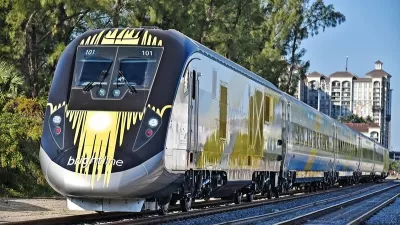Michael Cooper examines the factors leading to the death of a once-promising plan to connect Tampa and Orlando by bullet train.
It was not so long ago that Florida's high-speed rail project stood to be a "showpiece" for the rest of the country, writes Cooper. The federal government had agreed to fund $2.4 of $2.6 billion in construction costs, and railroad companies were competing to operate the new line. However, Cooper says, the project was doomed by both planning shortfalls and politics, with newly elected Governor Scott Walker ultimately killing it last month.
Cooper chronicles the political rise and fall of Florida's high-speed rail, from early championing by Governor Charlie Christ, a Republican with national ambitions, to more recent debates that echo a national trend of Republican governors opposing rail projects. Furthermore, he argues, the chief problem plaguing the project from the start was Tampa and Orlando's relative proximity. The two cities are only 84 miles apart.
Cooper writes:
"The Tampa-to-Orlando route had obvious drawbacks: It would have linked two cities that are virtually unnavigable without cars, and that are so close that the new train would have been little faster than driving. But the Obama administration chose it anyway because it was seen as the line that could be built first...In the end, though, the state's new governor decided not to build it at all, worried that those very drawbacks would ultimately make it a boondoggle."
FULL STORY: How Flaws Undid Obama’s Hope for High-Speed Rail in Florida

Alabama: Trump Terminates Settlements for Black Communities Harmed By Raw Sewage
Trump deemed the landmark civil rights agreement “illegal DEI and environmental justice policy.”

Planetizen Federal Action Tracker
A weekly monitor of how Trump’s orders and actions are impacting planners and planning in America.

The 120 Year Old Tiny Home Villages That Sheltered San Francisco’s Earthquake Refugees
More than a century ago, San Francisco mobilized to house thousands of residents displaced by the 1906 earthquake. Could their strategy offer a model for the present?

Ken Jennings Launches Transit Web Series
The Jeopardy champ wants you to ride public transit.

BLM To Rescind Public Lands Rule
The change will downgrade conservation, once again putting federal land at risk for mining and other extractive uses.

Indy Neighborhood Group Builds Temporary Multi-Use Path
Community members, aided in part by funding from the city, repurposed a vehicle lane to create a protected bike and pedestrian path for the summer season.
Urban Design for Planners 1: Software Tools
This six-course series explores essential urban design concepts using open source software and equips planners with the tools they need to participate fully in the urban design process.
Planning for Universal Design
Learn the tools for implementing Universal Design in planning regulations.
Clanton & Associates, Inc.
Jessamine County Fiscal Court
Institute for Housing and Urban Development Studies (IHS)
City of Grandview
Harvard GSD Executive Education
Toledo-Lucas County Plan Commissions
Salt Lake City
NYU Wagner Graduate School of Public Service




























